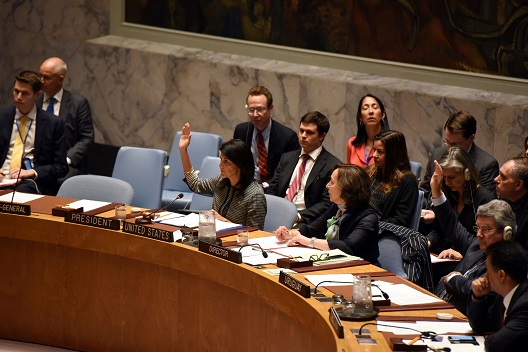 During the first six years of conflict in Syria, American diplomats tried to bring order to chaos but found themselves disabled by a White House determined not to alienate Iran. Consciously or not, the Trump administration has resurrected American diplomacy as a potential player in the Syrian crisis. It did so by using military force on April 6-7.
During the first six years of conflict in Syria, American diplomats tried to bring order to chaos but found themselves disabled by a White House determined not to alienate Iran. Consciously or not, the Trump administration has resurrected American diplomacy as a potential player in the Syrian crisis. It did so by using military force on April 6-7.
From the chemical red line fiasco of summer 2013 through noon, January 20, 2017, it was President Obama’s single-minded pursuit and preservation of a nuclear deal with Iran that made Secretary of State John Kerry’s Syria diplomacy an exercise in frequent flier futility. Iran’s Supreme Leader regarded his Syrian client, Bashar al-Assad, as uniquely willing to serve Hezbollah: the tip of Tehran’s spear into the Levant. Obama—not wishing to lose Iran—steadfastly refused militarily to complicate Assad’s strategy of mass homicide, all the while authorizing administration spokespeople to condemn Assad publicly. As time went on, Mr. Kerry’s Russian counterpart made no effort to disguise his contempt.
Assad’s backers—Russia and Iran—were impressed not at all by the eloquence of John Kerry, United Nations Ambassador Samantha Power, or President Obama himself in condemning the hellacious atrocities of Bashar al-Assad. Indeed, the gulf between word and deed only fed Russian contempt, with Moscow’s UN ambassador referring to Power as a would-be “Mother Theresa.” Having intervened militarily in Syria to save a useful war criminal on the false pretense of fighting ISIS, Moscow had avoided moralizing. President Vladimir Putin often alluded to American regime change machinations, but he calculated correctly that he was tilting at a straw man. The same confidence that animated the seizure of Crimea encouraged him to intervene in Syria.
For the Obama administration, Putin was waltzing into a quagmire: presumably the same one Obama claimed he had skillfully avoided. From October 2015 until the administration’s end, John Kerry’s leverage-free exercise in diplomatic alchemy amazed friend and foe alike. It was as if his late 2013 efforts to counter Assad’s post-chemical agreement civilian slaughter rampage with a pointless Geneva conference were but a dress rehearsal for the ultimate diplomatic burlesque.
On April 4, as he reviewed photos of Syrian children either killed by or struggling with the effects of sarin nerve agent, President Donald Trump realized something his predecessor had known for years: that Bashar al-Assad was a merciless killer with a refined taste for the terror-inducing qualities of chemical weaponry. And without downgrading his priority on the military defeat of the Islamic State (ISIS, ISIL, or Daesh) in Syria, Trump also appreciated, as he focused on the photos, the special gift to violent Islamist extremism personified by Assad.
The policy result of the Trump epiphany is striking. An administration that came to office willing to consider cooperating with Assad against ISIS suddenly got it: Assad, having made large swathes of Syria safe for ISIS and other extremists, was a big part of the problem. Administration officials who, only days earlier, were minimizing the importance of Assad’s political status, were suddenly singing from a different hymnal: Bashar al-Assad, as a practitioner and enabler of violent extremism, simply cannot be part of a Syrian political outcome aimed at stabilizing and rebuilding the country.
One need not debate the merits of the Iran nuclear accord to acknowledge its prohibitive costs: Syrian civilian suffering, the impact of refugees and migrants on the region and beyond into western Europe, and the loss of American credibility globally. The initial inclination of candidate Trump seemed to be one of magnifying his predecessor’s failure by seeking to enlist Putin and Assad in the battle against ISIS. That inclination is now gone, without a trace.
Whether it did so consciously or not, the Trump administration paid the diplomatic table ante for Syria by hammering Shayrat air base on April 6-7. The United States now has the attention of Iran and Russia. Respect will follow if both parties conclude that the cruise missile assault was not necessarily a one-time occurrence.
Sadly, neither Moscow nor Tehran blinks when it comes to civilian slaughter, whether by chemicals, barrel bombs, gravity bombs, starvation, torture, or pestilence. For both, it is all about securing Assad. For Moscow and Tehran, ISIS alive in Syria is a useful foil for their own regrettable client. But if the United States decides that henceforth it will oppose Assad’s mass terror political survival strategy—irrespective of the munitions the regime employs—even as it destroys ISIS, it will discover that Iran and Russia take it seriously: the prerequisite for serious diplomacy.
The Trump administration has given diplomacy a chance in Syria. But it must persist in preventing Assad from doing his worst to civilians and his best for ISIS. Otherwise Washington will merely perpetuate, in Syria, a disease communicable globally.
Frederic C. Hof is director of the Atlantic Council’s Rafik Hariri Center for the Middle East.
Image: Photo: U.S. Ambassador to the U.N. Nikki Haley votes for a draft resolution condemning the reported use of chemical weapons in Syria at the Security Council meeting on the situation in Syria at the United Nations Headquarters in New York, U.S., April 12, 2017. REUTERS/Stephanie Keith
